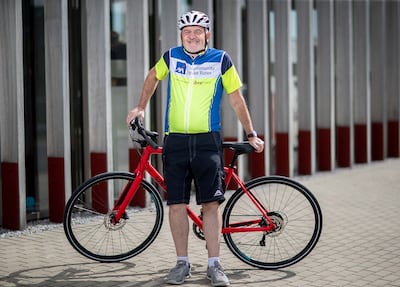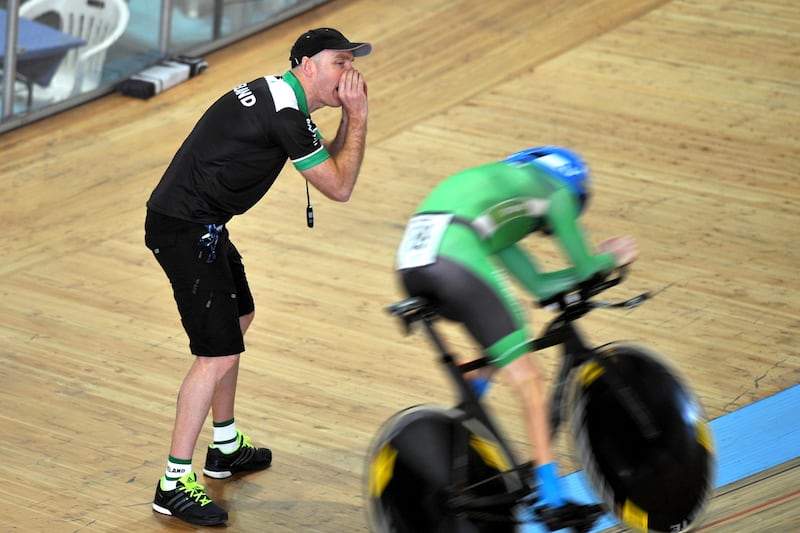Winter cycling is not everyone’s cup of tea. The days are cold and dark, and trying to dodge winter showers can often feel more effort than it is worth.
However, as the saying goes, “winter miles make summers smiles”, so if you can avail of winter cycling then here are some tips to keep you safe and motivated.
Cycling in a group can really help motivation during the winter months. The accountability of turning up on time to an organised session can do wonders for your motivation. So if you are not already in a club or regular group then seek one out for some help.
AXA Community Bike Rides is an ideal place to start as they cater for all levels of cycling, whether you want to get confident riding your bike in traffic around a town, you feel like you would like to train to a level to partake comfortably in summer sportives or are just looking for friends. The partnership between Cycling Ireland and the insurance company is hoping to encourage people out on their bikes.
Charlie Parsons, one of the ride leaders in Kilkenny, explains how to get started. "Go on the website, and register to become a member. Then you can go on every now and again, just look through the cycles. They are on all over the country."

Parsons organises spins of all lengths ranging from a 10-12km trip around Kilkenny City to longer rural “coffee spins” for those looking to up their mileage.
“It’s really great for anybody, especially for their mental health. You have to have your mental health right before everything else works for you,” says Parsons. “Being out on the bike has a nice feel to it, and you feel good after it. You are getting a bit of exercise and a bit of fresh air.”
Social cycles
Cathy Crowley has been participating in the social cycles for some years now, and is a regular in Parsons' Kilkenny group.
“The benefits of being part of a group; well, start with the fact that it’s the discipline to it. The cycle starts at 10am on a Saturday morning; you’ve signed yourself up to cycle so you make sure you get out. Whereas if you’re doing something on your own you can often find an excuse why you can’t go.
“And then there is the social aspect of it. It’s meeting people, it’s cycling along the road chatting as you go, it’s having the cup of coffee, and it’s feeling the joint achievement if we cycled a little bit further than we might previously had thought we could ever do. I’ve cycled more now as a result. This year I took part in the Great Dublin Bike Ride – now I only did the 60km.”
There is no "only" when it comes to cycling 60km no matter what level you are at, especially in the weather we're accustomed to in Ireland.
TIPS FOR WINTER CYCLING
There are some extra precautions that you need to take during the winter if you’re taking to the roads in a group or flying solo, and for those hoping to enhance their training over the winter we have top tips from Cycling Ireland’s national performance coach Neill Delahaye.
“Well, I think that the most important thing and maybe sometimes what gets overlooked are the basics. And the basics in the winter are really about keeping upright, dry and warm.”

– Have a set of mudguards on a winter bike. Even if it's not raining the roads can be wet and you can get destroyed – it becomes very uncomfortable very quickly if you've a wet bum, legs and feet. Mudguards will save all that, and out of courtesy to fellow riders in a group mudguards stop a lot of spray coming off the road and spraying their faces if they are behind you.
– There are more hazards on the road in the winter. The roads are slippier, there's more debris and more standing water. All these things can make it more hazardous. So stay upright. Don't go into a puddle blind. If it's safe to do so avoid going into puddles – you don't know if that puddle is a pothole.
– Tyre choice is a big thing. With the wet roads and frosty mornings, something with a deeper thread provides more grip. Tyres with a more puncture resistance and durability will save you a lot of hardship.
– Layering is important. No matter what the temperature, an extra layer up or down will mean you are accommodating what the conditions are. You can spend as much as you have on some of the jackets that are out there but layers underneath a cheap jacket will do more or less the same thing. I always suggest bringing a little rainproof cape or something that will provide an extra layer in case you get caught out in rain.
– A good pair of gloves. Get a pair of overshoes and a pair of gloves to keep your feet and hands warm and dry. One of the only moving parts on a bike visible to traffic behind you is your feet, and if you can get a pair of overshoes and incorporate some hi-viz, reflective material or a very bright colour then when your legs are spinning they enhance your visibility on the road.
I don’t think you can be seen enough. Flashing lights front and rear – you have to put yourself in the eyes of the driver, try to make yourself as visible as possible.
WINTER TRAINING
The work put in during the winter is essentially creating a big, strong aerobic base for you to build on when the weather gets better. That steady state or aerobic level of effort really comes back and pays dividends when you get into the spring. It is the consistency over time that builds up the aerobic endurance
I see more people than I think I like up mountains in the middle of winter. When you go up hills you’re kind of going really hard, yet when coming down your cruising or freewheeling. That’s not value for money in terms of time spent versus doing longer steadier spins on flatter roads.




















